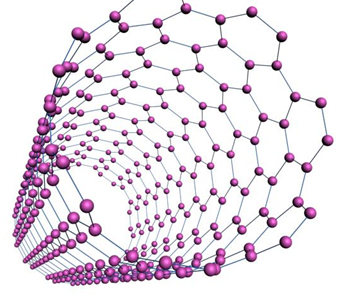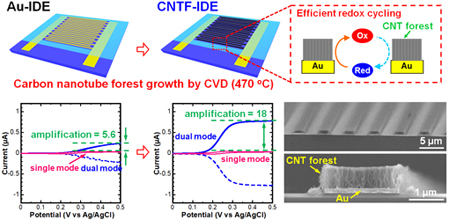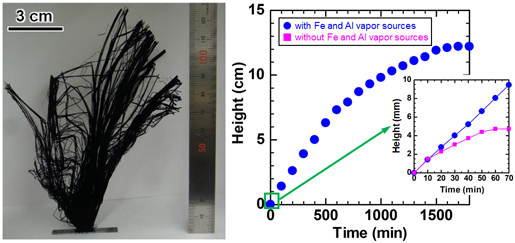In our laboratory, we are investigating various nanomaterials and applications based on chemical engineering, process engineering, and physical chemistry.
Even for the same material, the structure changes greatly depending on the synthesis process, and the function changes greatly depending on the structure.
To control the processes, it is important to have a deep insight for the mechanism of phenomena in addition to optimization of the conditions.
We are also actively collaborating with researchers in other fields to develop innovative next-generation technologies for environmental and healthcare issues.
Carbon nanotubes (CNTs) are tubular substances consisting only of carbon atoms, and have a tubular structure in which a sheet of carbon atoms connected in a hexagonal network is formed.
Due to its nanometer-scale diameter, high aspect ratio, and high electrical and thermal conductivity, various applications have been expected.
However, the high production cost and the difficulty of controlling the structure are obstacles to practical use.
We are working on the new methods for mass production and for new applications.

In order to apply CNTs to electrochemical devices, it is necessary to control electrical contact between CNTs and conductive supports.
Since the catalyst nanoparticles on conductive substrate are unstable, it is necessary to control the interfacial energy to form catalyst nanoparticles with high number density.

In our laboratory, we succeeded in growing the CNT forest with the highest mass density so far by designing the catalyst/substrate combination from the viewpoint of thermodynamics and kinetics (Publication page,
Paper [15], Paper [21], Paper [24]).
By applying this dense CNT forest to an electrochemical biosensor, we demostrated the measurement of dopamine, which is a neurotransmitter, with high sensitivity even in the presence of high concentrations of ascorbic acid (contaminants). In addition, the electrode with CNT forest was found to show excellent anti-fouling property (Publication page, Paper [38]).
In recent years, biotechnology and electronic devices are closely related, and the control of their interfaces has become important, thus the nanocarbon materials such as CNT and graphene will play more important role in future. Currently, we are developing more practical applications by designing new catalysts.
By applying this dense CNT forest to an electrochemical biosensor, we demostrated the measurement of dopamine, which is a neurotransmitter, with high sensitivity even in the presence of high concentrations of ascorbic acid (contaminants). In addition, the electrode with CNT forest was found to show excellent anti-fouling property (Publication page, Paper [38]).
In recent years, biotechnology and electronic devices are closely related, and the control of their interfaces has become important, thus the nanocarbon materials such as CNT and graphene will play more important role in future. Currently, we are developing more practical applications by designing new catalysts.
By growing CNTs in a forest shape on substrates with a high number density (> ~109 cm-2), long CNTs can be obtained with high efficiency.
Although 50-cm individual tubes were reported, the number density of CNTs is ~105 times lower compared to CNT forests.

It was understood that the structural change of the catalyst nanoparticles is one of the crucial reasons for the growth termination(Publication page, Paper [21]).
We have developed a new method where iron (Fe) and aluminum (Al) were supplied from the gas phase with trace amount.
By combining this method with recently developed gadolinium added catalyst (Fe/Gd/Al2Ox) (Publication page,
Paper [42]),
we realized both the rapid growth rate (~1.5 µm s-1) and the long catalyst lifetime (~26 h)
(Publication page, Paper [50],
Press release).
Under optimal conditions, growth lasted for 26 hours, resulting in the 14-cm-long CNT forest (growth movie in YouTube). In addition, by investigating the growth conditions in detail, we found that the addition of Fe and Al vapor sources has the effect of suppressing the structural changes of the catalyst nanoparticles during the CNT growth. Currently, we are conducting research to elucidate the mechanism and develop new growth methods.
Under optimal conditions, growth lasted for 26 hours, resulting in the 14-cm-long CNT forest (growth movie in YouTube). In addition, by investigating the growth conditions in detail, we found that the addition of Fe and Al vapor sources has the effect of suppressing the structural changes of the catalyst nanoparticles during the CNT growth. Currently, we are conducting research to elucidate the mechanism and develop new growth methods.
Growth movie of the long CNT forest (750 °C, 32 hours)

